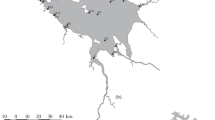Abstract
The results of studies of the concentrations and the ratios between the forms of organic matter in Volga reservoirs are presented. The reservoirs under consideration have different morphometric characteristics. flowage, and trophic status. Total organic matter content varies from 7.1 to 11.8 g/m3 or from 39.1 to 70.8 g/m2 with the proportion of labile fraction of 4.4–15.2%. The primary production of plankton, the daily value of which accounts for 14–40% of labile organic matter, has a notable effect on its concentration and input. Organic matter pool in Volga reservoirs forms under the effect of the morphometric features of reservoirs, water exchange, and the drainage area. The total characteristics of organic matter in the Upper Volga reservoirs have not experienced significant changes over the 20-year period. However, data for 2005 show that the contribution of primary production to the total concentration of organic matter and its labile fraction have decreased due to a decline in the productivity of planktonic communities recorded in recent years.
Similar content being viewed by others

References
Avakyan, A.B., Saltankin, V.P., and Sharapov, V.A., Vodokhranilishcha (Reservoirs), Moscow: Mysl’, 1987.
Avakyan, A.B. and Shirokov, V.M., Kompleksnoe ispol’zovanie i okhrana vodnykh resursov (Multipurpose Use and Protection of Water Resources), Minsk: Universitetskoe, 1990.
Alekin, O.A., Semenov, A.D., and Skopintsev, B.A., Rukovodstvo po khimicheskomu analizu vod sushi (Handbook on Chemical Analysis of Continental Waters), Leningrad: Gidrometeoizdat, 1973.
Bikbulatov, E.S., A Simple Method for Organic Matter Oxidation for the Determination of Carbon, Gidrokhim. Mater., 1974, vol. 60, pp. 174–179.
Bikbulatova, E.M. and Bikbulatov, E.S., Organic Matter in Reservoirs of the Middle and Lower Volga, Gidrokhimicheskie Issledovaniya Volzhskikh Vodokhranilishch (Hydrochemical Studies of Volga Reservoirs), Rybinsk: IBVV AN SSSR, 1982, pp. 101–112.
Bikbulatova, E.M., Stepanova, I.E., and Bikbulatov, E.S., Forms, Quantities, and Variability of Organic Substance Inflow into the Rybinsk Reservoir, Vodn. Resur., 2006, vol. 33, no. 3, pp. 338–343 [Water Resour. (Engl. Transl.), vol. 33, no. 3, pp. 310–320].
Bul’on, V.V., Pervichnaya produktsiya planktona vnutrennikh vodoemov (Plankton Primary Production in Inland Water Bodies), Leningrad: Nauka, 1983.
Butorin, N.V., Gidrologicheskie protsessy i dinamika vodnykh mass v vodokhranilishchakh volzhskogo kaskada (Hydrological Processes and Water Mass Dynamics in Volga System Reservoirs), Leningrad: Nauka, 1969.
Volga i ee zhizn’ (Volga and Its Life), Butorin, N.V. and Mordukhai-Boltovskii, F.D., Eds., Leningrad: Nauka, 1978.
Gidrometeorologicheskii rezhim ozer i vodokhranilishch SSSR. Vodokhranilishcha Verkhnei Volgi (Hydrometeorological Regime of Lakes and Reservoirs in the USSR. Reservoirs of the Upper Volga), Leningrad: Gidrometeoizdat, 1975, p. 292.
Datsenko, Yu.S., Assessing the Effect of the Volga Reservoirs Chain on the Normal Annual Phosphorus Runoff into the Caspian Sea, Vodn. Resur., 2002, vol. 29, no. 5, pp. 636–638 [Water Resour. (Engl. Transl.), vol. 29, no. 5, pp. 587–589].
Zakonov, V.V. and Ziminova, N.A., Nutrient Balance in Upper Volga Reservoirs, in Vzaimodeistvie mezhdu vodoi i sedimentami v ozerakh i vodokhranilishchakh (Water-Sediment Interaction in Lakes and Reservoirs), Leningrad: Nauka, 1984, pp. 114–122.
Korneva, L.G., Solov’eva V.V. Phytoplankton Structure and Distribution in Volga Reservoirs, in Ekologo-fiziologicheskie issledovaniya vodoroslei i ikh znachenie dlya otsenki prirodnykh vod (Ecological-Physiological Studies of Algae and Their Significance for Natural Water Assessment), Yaroslavl: YaGTU, 1996.
Litvinov, A.S., Energo-i massoobmen v vodokhranilishchakh Volzhskogo kaskada (Energy and Mass Exchange in Volga System Reservoirs), Yaroslavl: YaGTU, 2000.
Mineeva, N.M., Ecological-Physiological Aspects of the Formation of Plankton Primary Production in Volga Reservoirs Doctoral (Biol.) Dissertation, Nizhniy Novgorod: Nizhegorodskii Gos. Univ., 2003.
Mineeva, N.M., Concentrations of Photosynthetic Pigments in Upper Volga Reservoirs, Biologiya Vnutrennikh Vod, 2006, no. 1, pp. 31–40.
Odum, Yu., Fundamentals of Ecology, Philadelphia: Saunders, 1971.
Pyrina, I.L. and Lyashenko, G.F., Long-Term Dynamics of Phytoplankton Higher Aquatic Plant Production and Their Role in Organic Matter Production in the Overgrowing Ivankovo Reservoir, Biologiya Vnutrennikh Vod, 2005, no. 3, pp. 48–56.
Romanenko, V.I., Mikrobiologicheskie protsessy produktsii i destruktsii organicheskogo veshchestva vo vnutrennikh vodoemakh (Microbiological Processes of Production and Destruction of Organic Matter in Inland Water Bodies), Leningrad: Nauka, 1985.
Rybinskoe vodokhranilishche i ego zhizn’ (Rybinsk Reservoir and Its Life) Kuzin, B.S., Ed., Leningrad: Nauka, 1972.
Saltankin, V.P., Kayakin, V.V., Dmitrieva, I.L., and Mulina, A.V., Expert Assessment of the Geoecological State of Reservoirs in the Volga-Kama System, Abstracts of Papers, Tez. dokl. Vseross. konf. Aktual’nye problemy vodokhranilishch (All-Russia Conf. Urgent Problems of Reservoirs), Yaroslavl, 2002, pp. 269–270.
Ekologicheskie problemy Verkhnei Volgi (Ecological Problems of the Upper Volga) Kopylov, A.I., Ed., Yaroslavl: YaGTU, 2001.
Vannote, R.L., Minshall, G.W., Cummins, K.W., et al., The River Continuum Concept, Can. J. Fish. Auqat. Sci., 1980, vol. 37, no. 1, pp. 130–137.
Author information
Authors and Affiliations
Additional information
Original Russian Text © N.M. Mineeva, E.M. Bikbulatova, 2008, published in Vodnye Resursy, 2008, Vol. 35, No. 5, pp. 587–594.
Rights and permissions
About this article
Cite this article
Mineeva, N.M., Bikbulatova, E.M. The contribution of primary production to the overall organic matter pool in Volga reservoirs. Water Resour 35, 562–569 (2008). https://doi.org/10.1134/S0097807808050072
Received:
Published:
Issue Date:
DOI: https://doi.org/10.1134/S0097807808050072


